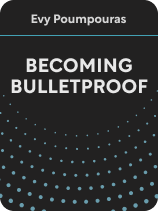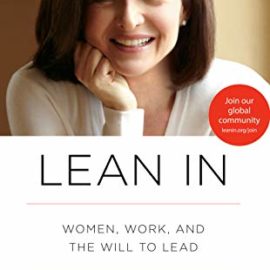

This article is an excerpt from the Shortform book guide to "Becoming Bulletproof" by Evy Poumpouras. Shortform has the world's best summaries and analyses of books you should be reading.
Like this article? Sign up for a free trial here.
Looking for an overview of Becoming Bulletproof by Evy Poumpouras? What’s her advice for becoming a more resilient person?
In Becoming Bulletproof, former Secret Service agent Evy Poumpouras helps you become a stronger, more resilient person. Through her time in the U.S. Secret Service, Poumpouras learned how to conquer her fears and overcome difficult physical and mental challenges.
Read on for an overview of Becoming Bulletproof—Evy Poumpouras’s book on dealing effectively with fear.
Becoming Bulletproof
In Becoming Bulletproof, Evy Poumpouras teaches you how to become a more resilient and effective person. This means being able to pursue the life you want without fear, problem-solve and cope with stress, and get what you need from other people. As a former special agent in the U.S. Secret Service, Poumpouras has extensive knowledge of controlling fear and dealing with stressful situations. As a former interrogator, she knows how to understand others’ true feelings and intentions through careful observation.
Understand Your Reaction to Fear
Poumpouras argues that to become a more resilient person, you need to first understand how fear influences you. Fear plays an important part in our lives. Fear can keep you safe in many situations, but it can also be debilitating and keep you from enjoying life. In this section, we’ll look at how we develop fears and how assessing our fears from a more logical perspective can help us cope with them and become more resilient.
The Two Types of Fear
In Becoming Bulletproof, Evy Poumpouras says there are two kinds of fear: innate and acquired. Innate fears are present from birth. The only two universal innate fears are the fear of falling and the fear of loud noises. We know they’re innate because even babies show signs of fear when they encounter heights or loud noises.
(Shortform note: Though Poumpouras claims there are only two universally recognized innate fears, there is evidence other fears are with us from birth. Many infants show signs that they’re naturally afraid of predators, pain, and rapidly approaching objects. For example, predators like snakes and spiders elicit a negative reaction from children as young as six months, before they’d be able to learn these creatures are dangerous.)
All other fears, according to Poumpouras, are acquired—in other words, fears we learn to have. Acquired fears come in many forms and from many places: from our personal trauma, our communities, the media, and from society as a whole. Our most persistent, harmful, and illogical fears usually stem from society and the media. This happens because the media highlights rare, sensational stories of danger—like a shark attack or plane crash—which make such stories seem more common, and thus more dangerous, than they are. While some acquired fears benefit us, Poumpouras argues that many acquired fears do more harm than good. This is because they can keep you from enjoying a happy and successful life without significantly increasing your survival rate. For instance, if you’re afraid of flying, you miss out on the enriching experience of travel. If you’re deathly afraid of sharks, you miss out on the simple joy of swimming in the ocean.
Understand Your Reaction to Danger
In Becoming Bulletproof, Evy Poumpouras argues that another way you can become more resilient is to understand how and why you normally respond to danger, conflict, or stress. Understanding which response is your default can help you modify that response to be more constructive.
When faced with immediate danger, we usually respond in one of three ways—fight, flight, or freeze. Let’s now look at these three responses and how understanding your typical response can help you deal with danger.
The Three Types of Responses to Danger
The fight, flight, or freeze responses to danger are the human body’s way of protecting itself. In general, people fight back when they feel they can defend themselves against a threat. When they feel they can get away from a threat, they flee. When they feel they can do neither, they freeze.
You can respond in such ways because, when met with danger, the body releases hormones that produce physiological responses to prepare you to deal with a threat. They cause your heart to beat faster, your breathing to increase, your pupils to dilate, and your muscles to tense. You become more focused, alert, and powerful.
(Shortform note: One of the dangers of the fight, flight, or freeze response is that it keeps us from using our brains effectively in crucial situations. When the fight or flight response kicks in, our brain essentially shuts down to allow our body to deal with this imminent danger. This can be a huge issue because some situations require a more thoughtful, careful approach, but our brains aren’t working at full capacity.)
Cope Effectively With Day-to-Day Problems
In addition to conquering fear and mitigating your responses to danger, Evy Poumpouras provides strategies in Becoming Bulletproof to help you become more resilient in your daily life. Doing this can help you find solutions to problems, deal with stress, and take control of your life. Strategies to build everyday resilience include facing reality, taking responsibility for your actions, and building a tolerance to stress.
Facing Reality
Although maintaining a certain degree of optimism is a helpful mental attribute, Evy Poumpouras argues in Becoming Bulletproof that accepting the reality of a situation is even more important to coping with it resiliently.
Finding this balance between optimism and realism can be tricky. The best approach is to hope for a positive outcome while still being aware of potential negative outcomes. This way, when you encounter a setback, you’ll be prepared, and you can focus on finding a solution to the problem. On the other hand, being overly optimistic can cause you to overlook potential problems or issues that may arise. Subsequently, when an issue or setback occurs, it will be more difficult to cope with it.
Another important aspect of facing reality is making sure you’re addressing the correct root cause of a problem. One way to do this is to get an outside perspective. Try asking a friend or family member for advice. In some situations, even asking an acquaintance or stranger can be helpful, as they may be able to provide an unbiased and honest perspective. Sometimes you can be so emotionally involved in your own problems that you fail to see the reality of the situation, but an outsider may be able to see the root of your problem more clearly.
| Remove Emotion and Ego From Your Worldview In The Discipline of Perception, Ryan Holiday explains how our perception of reality can affect our ability to identify problems and overcome obstacles: When you let your emotions or ego control the way you see the world, you give more power to them and let them control your life. Here are a few ways you can develop a neutral perception of reality: Turn bad situations into learning opportunities: If you don’t become overwhelmed with fear, anger, or other emotions during a mishap or crisis, you’ll be able to learn from it. Avoid helplessness: In some situations, you may feel like there is nothing you can do to change the outcome. This feeling of helplessness can be demoralizing, but you can avoid it if you remember that your actions do have an impact, no matter how small or insignificant they seem. Keep the goal in mind: Sometimes we get too caught up with how difficult a task is and lose sight of why we’re doing it. Keep the goal in mind, limit distracting thoughts, and you’ll stay motivated. |
Developing Tolerance to Stress
In Becoming Bulletproof, Evy Poumpouras recommends developing a tolerance to stress by exposing yourself to low levels of it. By developing a tolerance, you can alleviate some of this stress, overcome fears, and improve your ability to perform difficult tasks.
Poumpouras provides a five-step process to build your mental stress tolerance:
Introduce a stressor: Identify and introduce a stressor into your life. Start small so you don’t become overwhelmed. For instance, if you want to get over your claustrophobia, start by putting yourself in a space that is small enough to make you uncomfortable but large enough for you to handle.
Study your reaction: Take note of the way you feel and think and the way your body reacts when you introduce yourself to stress. For instance, when you entered the enclosed space, did you panic? Did your breathing intensify?
Make small changes: Identify small changes you can make to help you react more calmly and see what works. Try to control your breathing, or close your eyes and think about something that calms you.
Focus your effort: Once you know what works best for you, focus your efforts on one change that you think will help you the most. Perhaps you noticed that most of the panic comes from negative thoughts. Make positive thinking a priority.
Repeat: Repeat the first four steps, slowly adding more intensity to the stressors. Once you’ve mastered one change, focus on another. Over time, you should be able to turn a mental weakness into a strength.

———End of Preview———
Like what you just read? Read the rest of the world's best book summary and analysis of Evy Poumpouras's "Becoming Bulletproof" at Shortform.
Here's what you'll find in our full Becoming Bulletproof summary:
- How to become a stronger, more resilient person
- How to understand others’ true feelings and intentions
- Strategies to affect the way someone thinks or acts






